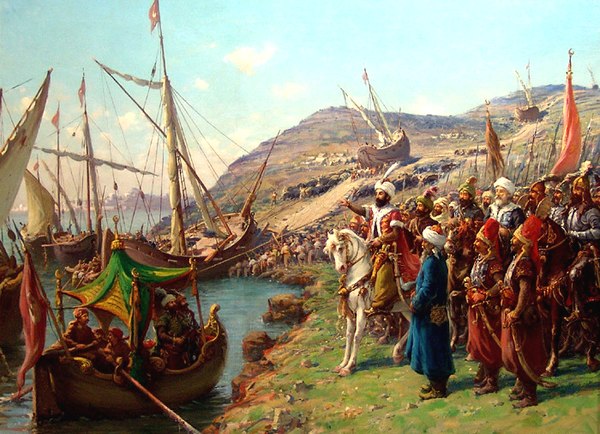Preparations for the final assault began in the evening of 26 May and continued to the next day. For 36 hours after the war council decided to attack, the Ottomans extensively mobilized their manpower for the general offensive. Prayer and resting was then granted to the soldiers on 28 May before the final assault would be launched. On the Byzantine side, a small Venetian fleet of 12 ships, after having searched the Aegean, reached the Capital on 27 May and reported to the Emperor that no large Venetian relief fleet was on its way. On 28 May, as the Ottoman army prepared for the final assault, mass religious processions were held in the city. In the evening, a solemn last ceremony of Vespers was held in the Hagia Sophia, in which the Emperor with representatives and nobility of both the Latin and Greek churches partook. Up until this point, the Ottomans had fired 5,000 shots from their cannons using 55,000 pounds of gunpowder. Criers roamed the camp to the sound of the blasting horns, rousing the Ghazis.
Shortly after midnight on Tuesday 29 May, the offensive began. The Christian troops of the Ottoman Empire attacked first, followed by successive waves of the irregular azaps, who were poorly trained and equipped and Anatolian Turkmen beylik forces who focused on a section of the damaged Blachernae walls in the north-west part of the city. This section of the walls had been built earlier, in the 11th century, and was much weaker. The Turkmen mercenaries managed to breach this section of walls and entered the city but they were just as quickly pushed back by the defenders. Finally, the last wave consisting of elite Janissaries, attacked the city walls. The Genoese general in charge of the defenders on land, Giovanni Giustiniani, was grievously wounded during the attack, and his evacuation from the ramparts caused a panic in the ranks of the defenders.[17]
With Giustiniani's Genoese troops retreating into the city and towards the harbour, Constantine and his men, now left to their own devices, continued to hold their ground against the Janissaries. Constantine's men eventually could not prevent the Ottomans from entering the city and the defenders were overwhelmed at several points along the wall. When Turkish flags were seen flying above the Kerkoporta, a small postern gate that was left open, panic ensued and the defence collapsed. Janissaries, led by Ulubatlı Hasan, pressed forward. Many Greek soldiers ran back home to protect their families, the Venetians retreated to their ships and a few of the Genoese escaped to Galata. The rest surrendered or committed suicide by jumping off the city walls.[18 ] The Greek houses nearest to the walls were the first to suffer from the Ottomans. It is said that Constantine, throwing aside his purple imperial regalia, led the final charge against the incoming Ottomans, perishing in the ensuing battle in the streets alongside his soldiers. The Venetian Nicolò Barbaro claimed in his diary that Constantine hanged himself at the moment when the Turks broke in at the San Romano gate. Ultimately, his fate remains unknown.
After the initial assault, the Ottoman army fanned out along the main thoroughfare of the city, the Mese, past the great forums and the Church of the Holy Apostles, which Mehmed II wanted to provide as a seat for his newly appointed patriarch to better control his Christian subjects. Mehmed II had sent an advance guard to protect these key buildings.The Catalans that maintained their position on the section of the wall that the emperor had assigned them, had the honor of being the last troops to fall. The sultan had Pere Julià, his sons and the consul Joan de la Via, amongst others, beheaded.
A few civilians managed to escape. When the Venetians retreated over to their ships, the Ottomans had already taken the walls of the Golden Horn. Luckily for the occupants of the city, the Ottomans were not interested in killing potentially valuable slaves but rather in the loot they could get from raiding the city's houses, so they decided to attack the city instead. The Venetian captain ordered his men to break open the gate of the Golden Horn. Having done so, the Venetians left in ships filled with soldiers and refugees. Shortly after the Venetians left, a few Genoese ships and even the Emperor's ships followed them out of the Golden Horn. This fleet narrowly escaped prior to the Ottoman navy assuming control over the Golden Horn, which was accomplished by midday.[18]
The army converged upon the Augusteum, the vast square that fronted the great church of Hagia Sophia whose bronze gates were barred by a huge throng of civilians inside the building, hoping for divine protection. After the doors were breached, the troops separated the congregation according to what price they might bring in the slave markets. The Venetian Barbaro observed that blood flowed in the city "like rainwater in the gutters after a sudden storm" and that bodies of Turks and Christians floated in the sea "like melons along a canal".[19]



























